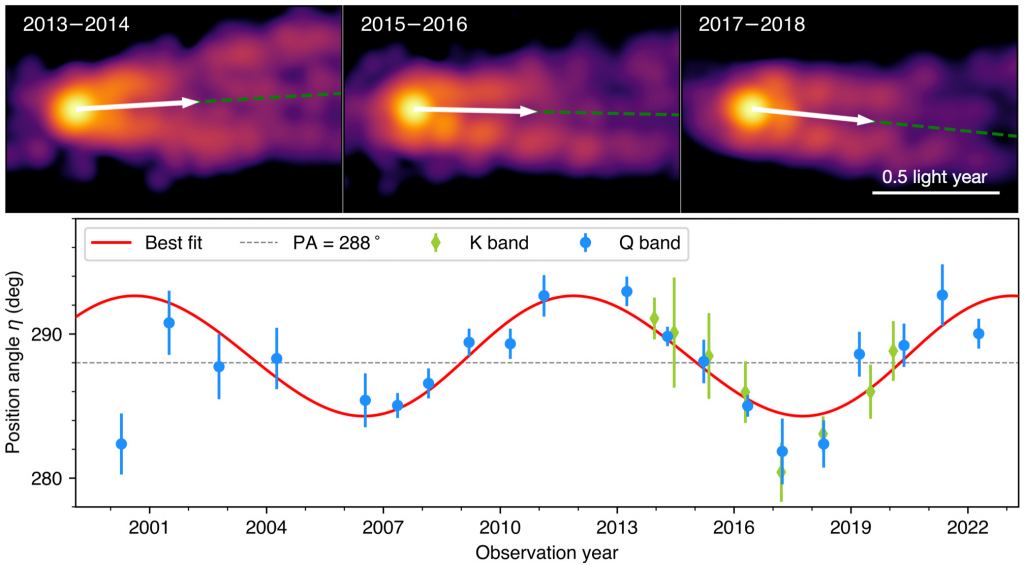Fifty-five million light-years away, in the galaxy known as M87, lies a supermassive black hole. It is a powerfully active black hole with a mass of 6.5 billion Suns, and in 2019 it was the first black hole to be imaged directly. The radio image captured by the Event Horizon Telescope (EHT) shows a halo of ambient light warped by the black hole’s gravity and directed our way. On one side of the halo, the light is brighter, which according to general relativity is due to the rotation or spin of the black hole. It was the first direct confirmation that the black hole rotates. A new study published in Nature has given us more rotational evidence.
It’s not surprising that M87’s supermassive black hole spins. Everything from stars to planets rotate, so astronomers expect that all black holes do as well. The challenge is proving it. Since black holes don’t have surface features, the only way you can determine black hole spin is by its torsional effect on space and time and how that affects nearby light, gas, and dust. The EHT observations are consistent with a rotating black hole, but of course, this assumes Einstein’s theory of general relativity is correct. So it would be nice to have some rotational evidence that doesn’t rely on that assumption.
 Radio image of the black hole in M87. Credit: EHT Collaboration
Radio image of the black hole in M87. Credit: EHT CollaborationThis new study looks at a rotational effect known as precession. You may have noticed this effect in things like spinning tops. If you set a top spinning, you might notice that its orientation slowly shifts. The axis of rotation precesses thanks to the pull of Earth’s gravity trying to make it fall. Lots of rotating bodies precess. Earth, for example, precesses thanks to the pull of the Moon. This is why thousands of years ago the north star wasn’t Polaris, but the star Thuban in the constellation Draco.
Since M87’s black hole is active, it generates tremendous jets that stream away from the rotational poles of the black hole at nearly the speed of light. If the black hole is precessing, then the direction of those jets should change over time. This is what the new study looked for.
The team analyzed more than 17 years of radio data on the black hole’s jet and found that the jet’s orientation shifted slightly over time. It oscillates over about 10 degrees with a periodic cycle of 8 – 10 years. This means the black hole’s axis of rotation is precessing within this range. Since precession is a direct effect of rotation, this confirms the black hole rotates.
 Precession of the M87 jet means the black hole rotates. Credit: Cui, et al (2023)
Precession of the M87 jet means the black hole rotates. Credit: Cui, et al (2023)Although the team confirmed rotation, the study does raise the question of what exactly causes the black hole to precess. Earth and tops precess because they experience a gravitational tug from another body. The M87 black hole is the largest mass in the room, and there isn’t a nearby body of similar mass. So what gives? The answer could lie in the Lense-Thirring effect, also known as frame dragging. In general relativity, a rotating mass twists spacetime around it, which means anything orbiting it can have a skewed orbit. The effect is tiny for bodies such as Earth, though it has been observed. For black holes, the Lense-Thirring effect can be powerful. It’s possible that this causes the accretion disk of material surrounding the black hole to be slightly askew, and when its material is consumed by the black hole it exerts a slight torque on the black hole, causing it to precess. If that’s true, then the jets of many other supermassive black holes should see a similar effect.
What’s great about this study is that it gives us solid data on the dynamic behavior of a black hole. We don’t have to rely purely on computational models to understand how black holes interact with their environment. We can now compare models to data, which will help us not only better understand black holes, but also the galaxies in which they live.
Reference: Cui, Yuzhu, et al. “Precessing jet nozzle connecting to a spinning black hole in M87.” Nature 621.7980 (2023): 711-715.

